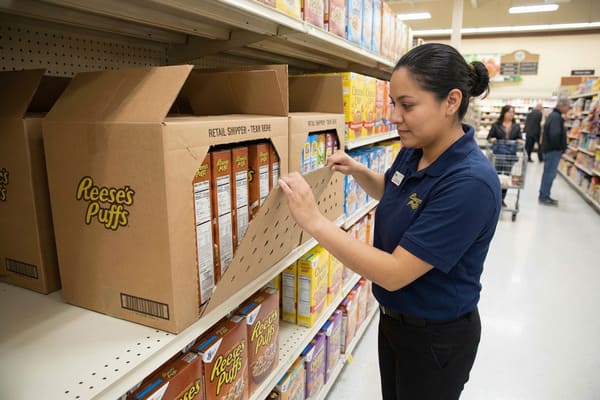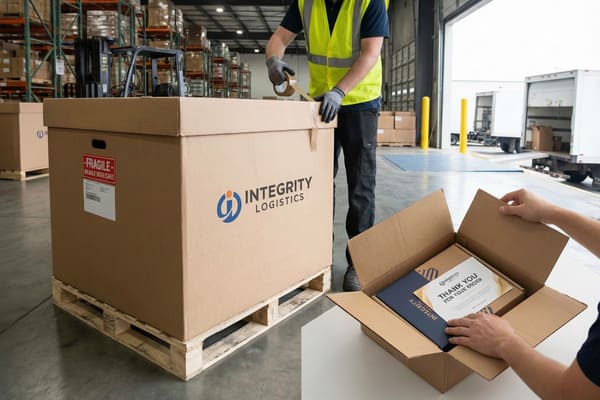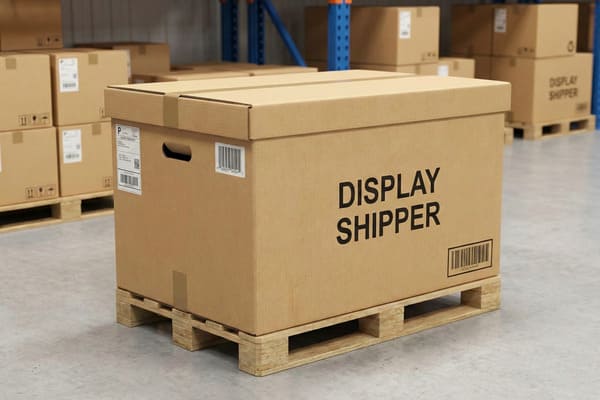Retailers push for faster stocking speeds, and you need your products to stand out immediately. You might struggle to balance safe shipping with instant shelf appeal. There is a solution that handles both tasks perfectly.
A display shipper is a dual-purpose packaging solution that functions as a sturdy shipping container during transit and transforms into a marketing display unit upon arrival at retail stores. It eliminates the need for unpacking, allowing staff to place products directly onto shelves or counters for immediate sale.

Let’s look at how this specific tool changes the way we manage inventory and merchandising strategies in the modern retail environment.
What is a shipper in retail?
Getting products from the factory to the store floor is often chaotic. Retail staff hate complicated boxes, and you lose sales when stocking takes too long or looks messy.
In retail, a shipper refers to the outer carton used to transport goods from the manufacturer to the distribution center or store. Unlike standard brown boxes, modern retail shippers often feature perforated tear-away sections, allowing them to serve as immediate inventory storage or shelf organizers without additional handling.

The Logistics and Merchandising Hybrid
The concept of a shipper in retail has evolved from a simple protective shell into a sophisticated tool for efficiency. In the past, a shipper was just a brown box (RSC – Regular Slotted Container) that a stock clerk would cut open, unpack, and discard. Today, retailers like Costco and Walmart demand "Retail Ready Packaging1" (RRP). This means the shipper must survive the supply chain and then look good on the shelf. This puts immense pressure on the structural design. The box needs enough stacking strength, known as BCT (Box Compression Test2), to support the weight of pallets stacked on top of it during transport.
However, the cardboard cannot be so thick that it is impossible to tear open. We usually use B-flute or E-flute corrugated board for these hybrid shippers. The challenge lies in the perforations. If the perforation cuts are too deep, the box splits open in the delivery truck, damaging the goods. If the cuts are too shallow, the store clerk struggles to open it, often resulting in jagged, ugly edges that hurt the brand image. We also have to consider the print surface. A standard shipping box uses low-grade recycled liner, which makes printing look dull. A retail shipper uses a high-quality white top liner (often clay-coated) to ensure the logos and colors pop. This balance between logistics strength and aesthetic quality is what defines a modern retail shipper.
• Comparison of Standard Shipper vs. Retail Ready Shipper
| Feature | Standard RSC Shipper3 | Retail Ready Shipper (PDQ)4 |
|---|---|---|
| Primary Function | Protection only | Protection and Display |
| Opening Mechanism | Tape and box cutter | Perforated tear-away strips |
| Material Grade | Standard Kraft (Brown) | White Top / High Quality Print |
| Labor Cost | High (unpacking required) | Low (place and go) |
| Shelf Appearance | Messy (loose product) | Organized (tray containment) |
I operate three production lines dedicated to finding this balance. My team runs specific burst strength tests on every batch of cardboard to ensure the perforations hold during shipping but yield easily for the store clerk. We make sure your product arrives safe and hits the shelf looking professional without issues.
What is display in merchandising?
Your product might be great, but it is invisible if it sits flat on a crowded shelf. You need to grab the shopper’s eye before they walk past your aisle.
A display in merchandising is a strategic presentation tool designed to highlight specific products, separate them from competitors, and drive impulse purchases. It uses visual hierarchy, structural design, and brand messaging to interrupt the shopper’s journey and convert passive traffic into active sales within the retail environment.

Visual Engineering and Shopper Psychology5
When we discuss "display" in the context of merchandising, we are talking about structural engineering combined with psychological triggers. A cardboard display is not just a holder; it is a stage. In high-volume retail, a consumer glances at a section for less than three seconds. The display must communicate the brand value instantly. We achieve this through structural height and print quality. For example, a floor display acts as a "speed bump" in the aisle, forcing the shopper to navigate around it and notice the product. A countertop display takes advantage of the "wait time" at the checkout register to trigger impulse buys.
The material choice is critical here. We use corrugated cardboard6 because it allows for complex shapes that rigid materials like metal or wood cannot easily achieve. We can fold the board to create headers, tiered shelves, and gravity-feed systems. The print finish is equally important. We often use lithographic lamination for displays. This involves printing on a smooth sheet of paper and then gluing it to the corrugated cardboard. This provides a glossy, magazine-quality image that suggests high value. If the colors are washed out, the consumer assumes the product is old or low quality. Stability is the final factor. A display that wobbles or leans forward creates a safety hazard and looks cheap. We engineer internal supports, often invisible to the shopper, to ensure the display remains rigid even as products are removed.
• Key Display Types and Strategic Uses
| Display Type | Location | Primary Goal |
|---|---|---|
| Floor Display7 | Aisles / End-caps | High volume sales, new product launches |
| Counter Display8 | Checkout / Service Desk | Impulse items, small accessories |
| Pallet Display | Open floor space (Costco) | Bulk sales, club store requirements |
| Power Wing / Sidekick | Hanging on shelf sides | Cross-merchandising, saving space |
I know that poor color matching ruins a brand’s reputation. My factory uses advanced color management systems to ensure the print on your display matches your brand guidelines exactly. We provide 3D renderings and free prototypes until you are satisfied, guaranteeing the final structure is stable and visually stunning.
What is the definition of a shipper?
Definitions matter because miscommunication leads to shipping damage and lost inventory. You need to know exactly what you are ordering to avoid costly mistakes at the manufacturing stage.
The definition of a shipper is the outermost protective container, typically made of corrugated fiberboard, used to consolidate multiple units of a product for storage and distribution. It is specifically engineered to withstand the mechanical stresses of the logistics chain, including stacking, vibration, and impact.

Defining the Protective Shell
Technically speaking, the definition of a shipper revolves around its material composition and structural testing ratings. A shipper is almost exclusively made from corrugated board, which consists of fluted sheets sandwiched between flat liners. The industry defines these based on wall construction: Single Wall (3 layers) is common for lighter goods, while Double Wall (5 layers) is used for heavy or fragile items. The critical metric here is the Edge Crush Test (ECT)9. A standard shipper might be rated as 32 ECT, meaning it can withstand 32 pounds of pressure per inch on the edge before buckling. This rating tells logistics companies how high they can stack these boxes in a warehouse without the bottom box collapsing.
Another key part of the definition is the "Master Case" versus the "Inner Pack." A Master Shipper might contain four Inner Packs, and each Inner Pack contains twelve retail units. Understanding this hierarchy is vital for pricing and logistics. If you order a "shipper" but do not specify if it is a Master or Inner, you might end up with the wrong size or quantity configuration. Furthermore, the dimensions of a shipper define the shipping cost. Carriers use "Dimensional Weight" (Dim Weight) pricing. If your shipper definition includes too much empty air or unnecessary padding, you pay for space, not weight. Therefore, a well-defined shipper is one that is optimized to fit the pallet perfectly with zero overhang, maximizing space efficiency in containers.
• Common Shipper Technical Ratings
| Rating Standard | Measurement Focus | Best Application |
|---|---|---|
| 32 ECT | Stacking Strength10 | Standard retail distribution |
| 44 ECT | High Stacking Strength | Heavy products, tall pallets |
| 200# Mullen | Bursting Strength11 | Individual parcel shipping (FedEx/UPS) |
| 275# Mullen | High Burst Resistance | Heavy, sharp, or rough handling items |
I ensure that every shipper we produce meets strict international standards. My team calculates the optimal material grade based on your product weight to prevent collapse, and we optimize the dimensions to help you save on shipping costs by reducing wasted space in the container.
What is the role of a shipper?
It is not just about moving boxes from point A to point B. The shipper plays a massive role in protecting your profit margins and your brand reputation.
The role of a shipper is to protect product integrity throughout the supply chain, facilitate efficient handling and storage, and increasingly, to act as a brand ambassador upon arrival. It bridges the gap between manufacturing and the final consumer touchpoint.

Protection, Promotion, and Efficiency
The primary role of a shipper is undeniably protection. It acts as the first line of defense against humidity, vibration, and compression. In international shipping, containers experience massive temperature fluctuations. A poor-quality shipper will absorb moisture, become soft, and crush under the weight of the stack. This results in "unsalable" goods. The shipper must maintain its structural integrity12 from the factory floor in Shenzhen all the way to a warehouse in Ohio. Beyond protection, the role has shifted towards efficiency. Retailers are cutting labor hours. They want shippers that are easy to identify in the warehouse (clear labeling) and easy to open on the floor.
There is also a growing role in sustainability. The shipper is often the largest component of packaging waste. Its role is now to be fully recyclable. We are seeing a shift away from wax-coated boxes (which are hard to recycle) to water-based coatings that offer similar protection but enter the recycling stream easily. Additionally, the shipper plays a silent marketing role. Even if it is not a display unit, a branded shipper with a clear logo builds confidence with the retailer. When a store manager sees a high-quality, undamaged shipper, they subconsciously assign higher value to the product inside. Conversely, a beat-up, unbranded brown box implies a generic or low-tier product.
• The Multifaceted Roles of a Shipper
| Role | Function | Benefit |
|---|---|---|
| Guardian | Physical barrier | Prevents returns and damages |
| Informant13 | Barcodes and labels | Speeds up inventory tracking |
| Ambassador | Branding on box | Professional image to retailer |
| Eco-Warrior14 | Recyclable material | Meets sustainability goals |
We take the role of your packaging seriously. I offer free structural design modifications to ensure your shipper performs its role perfectly, and we use certified sustainable materials so you can meet your environmental targets while keeping your products safe.
Conclusion
A display shipper is your secret weapon for retail efficiency. It protects your goods, reduces store labor, and boosts visibility. By choosing the right partner, you ensure sales growth and safety.
Explore this link to understand how Retail Ready Packaging enhances efficiency and brand visibility in retail. ↩
Learn about the Box Compression Test to see how it ensures the structural integrity of packaging during transport. ↩
Learn about Standard RSC Shippers to understand their protective capabilities and cost implications. ↩
Explore the advantages of Retail Ready Shippers for efficient product display and reduced labor costs. ↩
Understanding Shopper Psychology can enhance your merchandising strategies, leading to better customer engagement and increased sales. ↩
Exploring the benefits of corrugated cardboard can reveal its advantages in creating effective and eye-catching retail displays. ↩
Explore how Floor Displays can boost sales and enhance product visibility in retail environments. ↩
Learn about the impact of Counter Displays on consumer behavior and their role in increasing impulse purchases. ↩
Understanding the Edge Crush Test is crucial for ensuring your packaging can withstand shipping pressures, preventing damage and loss. ↩
Understanding Stacking Strength is crucial for ensuring your products are safely transported and stored. ↩
Learn about Bursting Strength to choose the right packaging for your parcels, ensuring they withstand pressure during transit. ↩
Understanding structural integrity is crucial for ensuring the safety and quality of goods during transport. ↩
Learn about the importance of barcodes in streamlining inventory processes and boosting efficiency. ↩
Explore how adopting eco-friendly practices can enhance your brand’s sustainability and appeal. ↩




